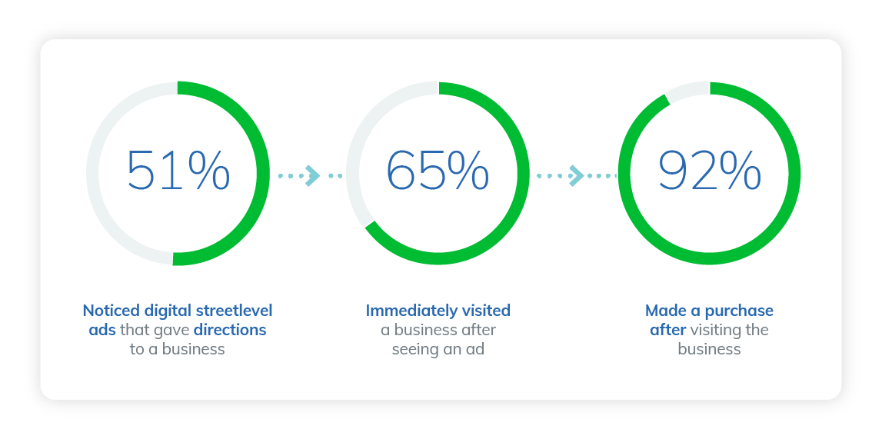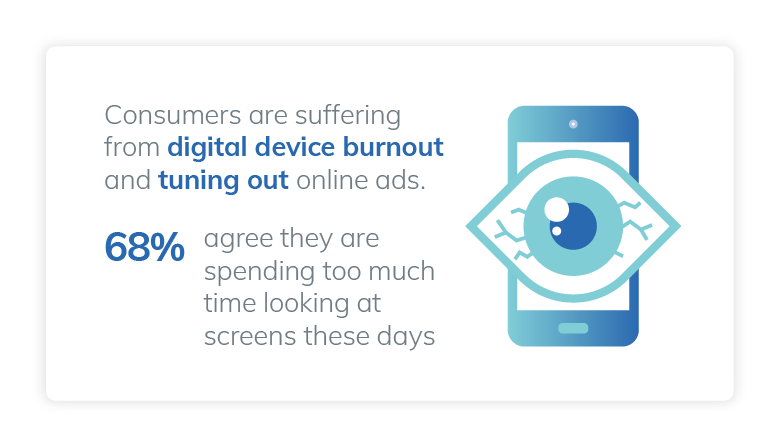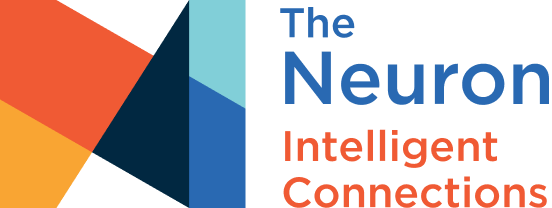DOOH marketing – can it really be worthwhile for SMBs?
Well, consider this. 49% of consumers notice digital street level ads per month, according to recent Nielsen research. Even better, 51% notice digital street level ads when they give directions to a business, and 65% of those visit the business after seeing a DOOH ad.
It’s easy to see the appeal digital out of home (DOOH) offers small, independent and local businesses looking for marketing strategies with tangible results.

(Image source: oaaa.org)
However, though this appeal has perhaps always been there for SMBs, it has been marred by barriers like costly expenses on advertisers, lack of transparency and limited targeting options. Remove these barriers and you have a medium that’s ideal for smaller, independent and local businesses looking to expand their customer base and increase brand recognition.
Thanks to new technologies that enable automated buying processes and increased availability, digitally displayed public ads are now a feasible – and highly effective – option for SMBs.
Here’s why DOOH marketing is changing from a difficult-to-access medium to one that offers a range of attractive benefits to smaller businesses.
Digital Out of Home Advertising Today
Until very recently, digital out of home advertising posed the same pain points as traditional OOH advertising for SMBs. That is to say that accessing digital screens on which to display advertising messages was a complicated and expensive process, and there were limited ways to control when and where ads played out.
The bigger issue here? Though both traditional and digital OOH provided mass audience potential, the lack of targeting options put limitations on the effectiveness of a campaign – reaching an audience of thousands (or more) is of little use if that audience isn’t right for your product.
Combined with the fact that purchasing ad space on digital screens has historically been a time-consuming process involving numerous intermediary agencies, and it’s no wonder that SMBs have largely shied away from experimenting with DOOH campaigns in the past.
However, thanks to the advent of state-of-the-art programmatic buying methods, this is all changing.
What Is Programmatic DOOH?
Whilst still a relatively new approach to buying DOOH ads, programmatic DOOH is breaking into mainstream media buying processes for digital OOH and outdoor advertising.
Programmatic DOOH (or pDOOH) replaces traditional media buying methods with an automated bidding platform similar to those used to buy online advertising. This offers SMBs three major advantages over traditional OOH:
- Buyers can specify the conditions under which their ads should appear to target audiences more effectively, for example audience segmentation data, average weekly impressions’ data, weather data etc
- Buyers can access campaign analytics in real time to optimize campaigns instantly
- Buyers can access the mass audiences offered by DOOH without huge resource spend
In other words, programmatic DOOH marketing democratizes access to digital display advertising, like digital billboards on highways and digital signage on street furniture. As such, digital outdoor advertising is no longer the reserve of those with bottomless budgets and large marketing teams.
How Does pDOOH Help SMBs Grow Their Customer Base?
Place-based DOOH media is ideal for attracting passing trade into restaurants, bars, retail outlets and any other brick-and-mortar business with nearby premises.
The programmatic buying process unlocks this advantage of DOOH for SMBs, who can’t afford to spend big on ‘hit and hope’ campaigns with limited ways to track success.
When you use a programmatic buying platform to find the ad space you need, you specify the conditions under which your creative should be displayed. This helps you define and attract the ideal target audience for your business, right when they’re ready to buy.
pDOOH platforms automate the bidding process so that your ad only goes live when your preset conditions are met.
To give just a few examples, businesses use pDOOH to:
- Advertise on specific days (for example, sports bars on game day)
- Advertise based on weather (for example, hot drinks on cold days and vice versa)
- Advertise based on time (for example, coffee to morning commuters)
- Advertise based on internal metrics (for example, when ticket sales are low)
Ultimately, you only pay to advertise when you know your audience is ready to buy. This opens up your brand to customers who might have walked past on another day, meaning you can grow your customer base, increase engagement and improve brand awareness much more effectively than with traditional OOH.
Why Does pDOOH Offer Better Analytics than Traditional OOH?
It’s important to understand that traditional OOH advertising does offer some analytics. The issue is that these are usually in the form of reports from media agencies, often issued days or weeks after the data was collected.
As a small business, it’s important to make every penny count. Running an ineffective campaign for two weeks whilst you wait for the figures to come through is far from ideal.
Because programmatic DOOH marketing takes place on an automated platform, that platform captures advertising campaign data immediately. This means analytics are available in real time. Campaign optimization can be immediate, so you can adapt your approach where needed and get a greater return on your campaign spend.
pDOOH Avoids Online Burnout
When was the last time you clicked on a banner ad online?
It probably won’t surprise you to learn that the click through rate for online banner ads is less than 0.1%. There are many reasons for this, but a major factor is that they are invasive.
Typically, users will be trying to do something else online when you advertise to them – working, catching up with friends and family on social media, etc. – and online ads are an unwelcome, annoying distraction.

(Image source: oaaa.org)
Combined with the fact that 68% of consumers experienced digital burnout in 2020, this means that online ads are often ignored (at best) or actively detrimental to the perception of your brand (at worst).
Because DOOH displays target people whilst traveling (for example, digital billboards) or whilst they are in public places (for example, digital signage on public transport), DOOH ads cut through the thousands of competitors advertising online and speak to audiences whilst they are more receptive. Moreover, DOOH advertising is considered to be highly trustworthy and credible due to its very nature, the measures taken by advertisers, together with their wish to engage with their prospect and customer base and to develop a long-lasting relationship.
Finding the Right DOOH Marketing Platform for You
To maximize the value you get from your DOOH marketing strategy, the programmatic buying platform you use should offer:
- An intuitively designed interface
- Automated bidding on a wide range of inventory
- One-click upload and go-live processes
- In-depth analytics
The Neuron is an easy-to-use demand-side platform that connects you to inventory owners without the need for intermediary agencies. Simply upload your ad creatives, specify your bidding criteria, and let the platform do the rest.

